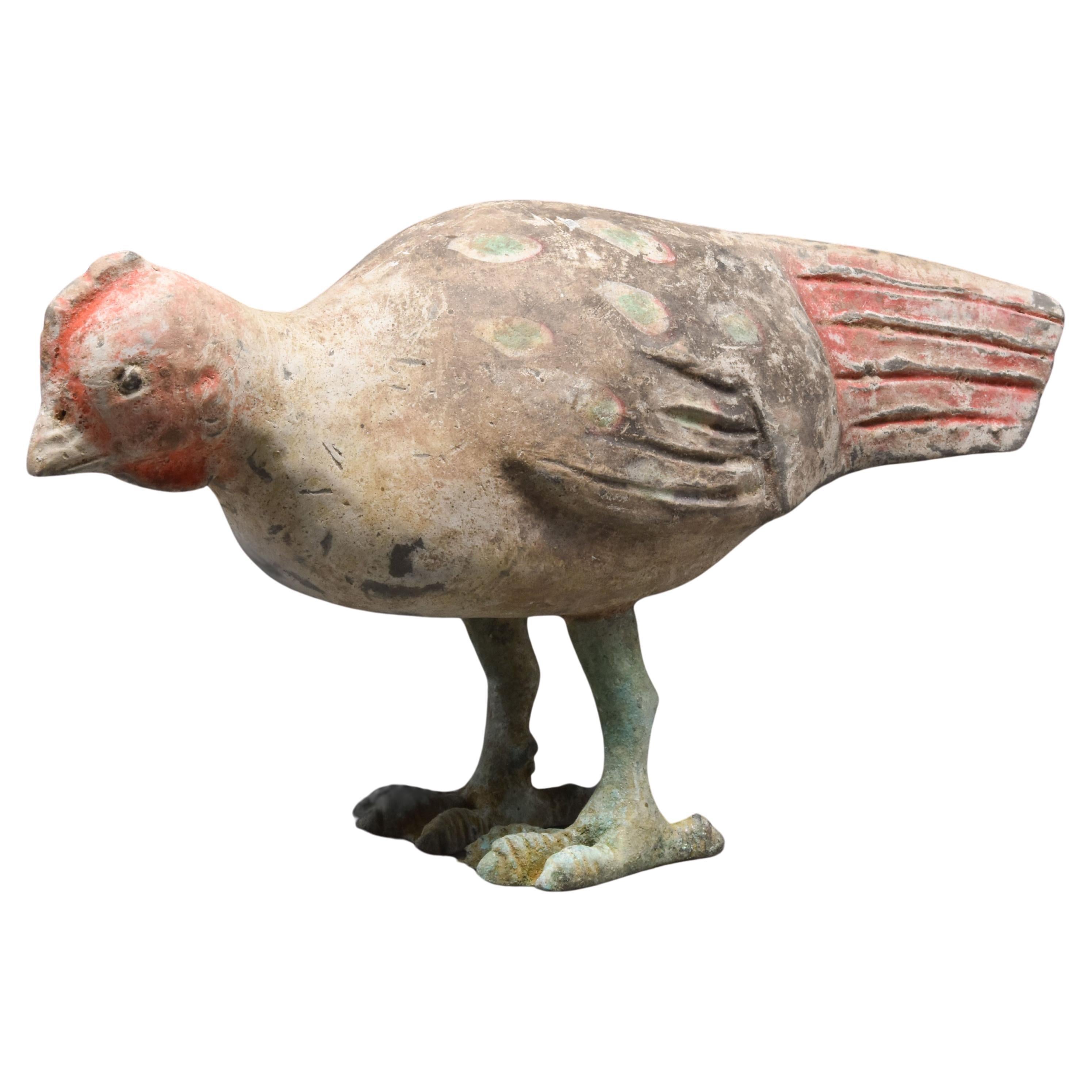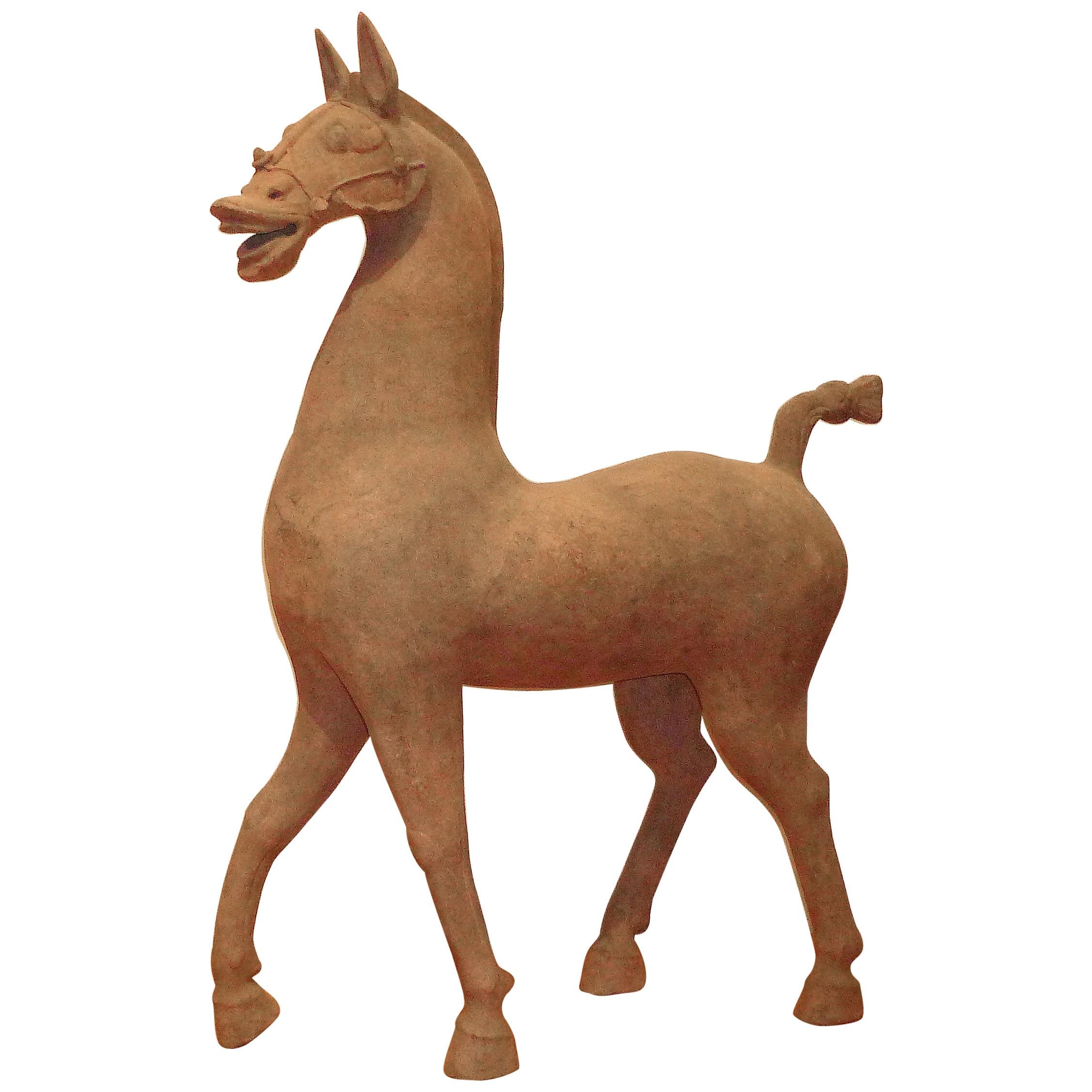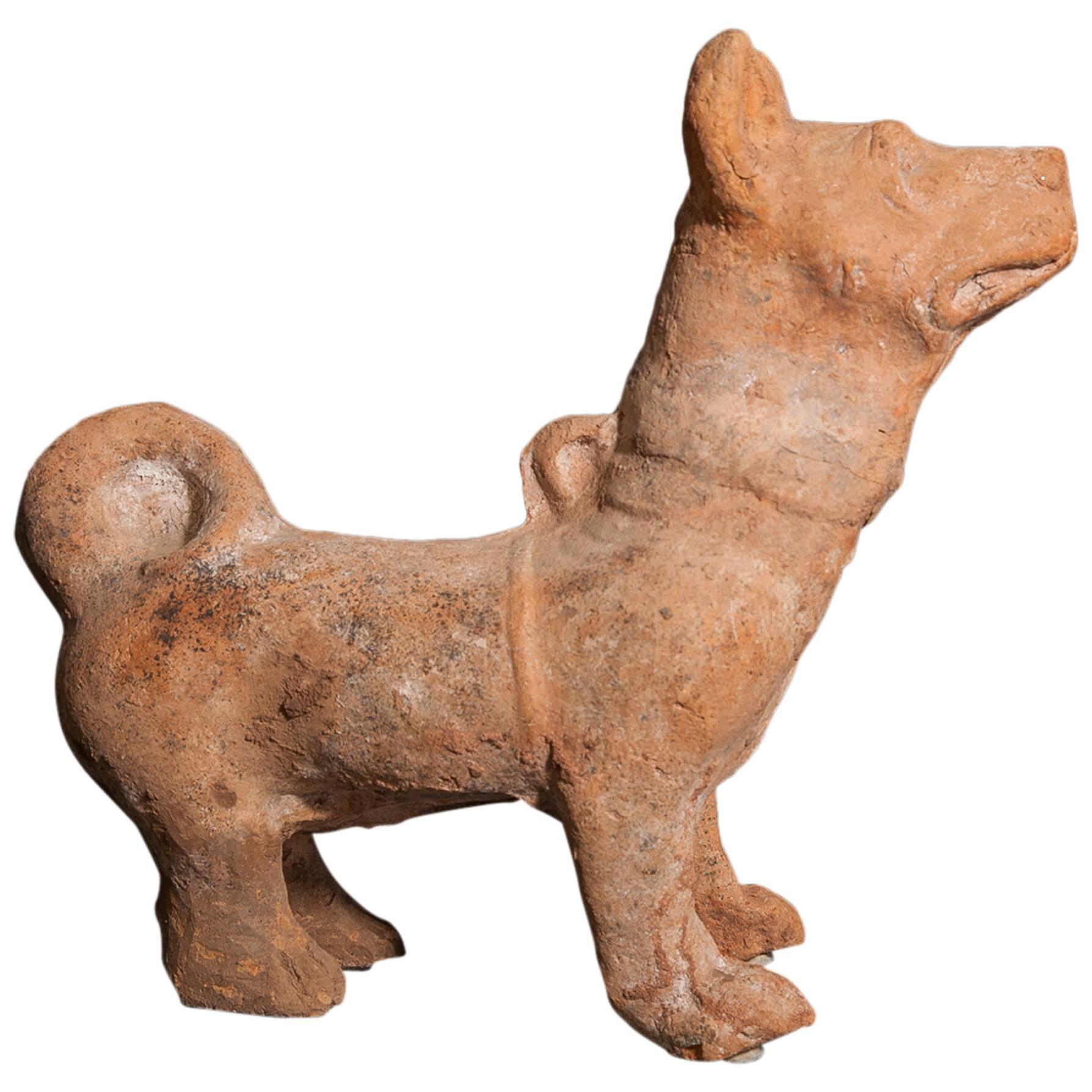Items Similar to Chinese Han Dynasty Terracotta Figyure of Shar Pei Dog - TL Tested
Want more images or videos?
Request additional images or videos from the seller
1 of 6
Chinese Han Dynasty Terracotta Figyure of Shar Pei Dog - TL Tested
About the Item
A beautiful Chinese terracotta shar pei dog, crafted with remarkable skill and artistry, this magnificent Chinese pottery model of a seated Shar Pei dog showcases a seated canine in a forward-facing position, with an alert expression captured through the raised head and pricked-up ears. The dog is adorned with an elaborate harness and a collar, further accentuating the attention to detail in its creation.
During the Han Dynasty, dog figures like this one held significant cultural and symbolic meanings. These pottery models were primarily created for funerary purposes, intended to serve as guardians and protectors in the afterlife. They were commonly placed in tombs as part of the burial rites, accompanying the deceased on their journey to the next world. The belief was that these guardian dogs would ward off evil spirits and provide protection for the individual in the afterlife. The inclusion of these guard dog figures in Han Dynasty funerary practices reflects the cultural beliefs and spiritual traditions of the time. The Han Dynasty, which spanned from 206 BC to AD 220, was characterised by a complex system of beliefs and rituals surrounding death and the afterlife. It was believed that the deceased required various provisions and protections in their journey to the afterlife, and the inclusion of symbolic objects such as the guard dog figures served as a means to fulfill these spiritual needs. In addition to their funerary function, dog figures like this pottery model also held symbolic significance within Han Dynasty society. Dogs were highly regarded for their loyalty, courage, and protective nature, and these qualities were attributed to the guardian role they played in the afterlife. The inclusion of such figures in burial contexts not only represented the practical need for protection but also symbolised the hope for a safe and secure passage into the next realm. Cf. The Indianapolis Museum of Art, Accession number 1999.2A-B. This piece has been precisely dated having undergone Thermo Luminescence analysis by Ralf Kotalla, its TL certificate with the full report will also accompany this piece.
Provenance: East Anglian private collection; formerly acquired in the early 1990s in Hong Kong.
- Dimensions:Height: 20.48 in (52 cm)Width: 7.29 in (18.5 cm)Depth: 13.78 in (35 cm)
- Materials and Techniques:
- Period:
- Date of Manufacture:Ca. 202 BC - AD 220
- Condition:Wear consistent with age and use. Minor fading.
- Seller Location:London, GB
- Reference Number:
About the Seller
No Reviews Yet
Vetted Seller
These experienced sellers undergo a comprehensive evaluation by our team of in-house experts.
1stDibs seller since 2022
- ShippingRetrieving quote...Ships From: London, United Kingdom
- Return PolicyA return for this item may be initiated within 14 days of delivery.
More From This SellerView All
- Chinese Han Dynasty Terracotta Bird - TL TestedLocated in London, GBA beautiful terracotta bird that stands on a pair of well-defined bronze legs with large, splaying feet. These support a globular body and slender neck, stretched forwards. The remai...Category
Antique 15th Century and Earlier Antiquities
MaterialsTerracotta
- Chinese Han Dynasty Terracotta Rabbit - TL TestedLocated in London, GBA large terracotta rabbit that is depicted in an extremely naturalistic manner, characteristic of Han Dynasty artistic practice. It is depicted in a recumbent pose, ears bent backwar...Category
Antique 15th Century and Earlier Antiquities
MaterialsTerracotta
- Chinese Tang Dynasty Terracotta Bull - TL TestedLocated in London, GBA naturalistic representation of a Chinese Tang Dynasty bull in a standing pose. This beautiful figure has its neck bent and head angled downwards, with a curved belly with a hole an...Category
Antique 15th Century and Earlier Antiquities
MaterialsTerracotta
- Chinese Northern Wei Dynasty Terracotta Horse - TL TestedLocated in London, GBAn elegant hollow-moulded terracotta horse. This horse is modelled in a standing pose with its neck elegantly arched and its ears pricked forward attentively. The mane is indicated with the use of a scalloped red design with white dotted details. The head is well modelled with notched ears pricked on either side of a feather ornament, with a tasselled rope looped around the top of the neck and tufted ornaments on the chest collar, the back is covered with a long red cloth with white dotted detailing, gathered at the bottom atop the flaring mudguard. The rump is encircled by a series of intricate tassels, attached to a tufted back piece. This terracotta may represent a horse fitted for a parade. Horses were an important status symbol in ancient China. These animals were brought to China via the Silk Road and were considered luxury goods. As such horses were a sign of wealth among the elite, and there were strict laws which restricted the ownership of horses to people of elevated rank. In fact, soldiers serving in China’s military...Category
Antique 15th Century and Earlier Antiquities
MaterialsTerracotta
- Chinese Song Dynasty Green Glazed Buddhist Funerary Jar and Cover - TL TestedLocated in London, GBA vibrant Song Dynasty funerary urn that captures the short-lived, yet fruitful period of Song dynasty artistic production. The body is globular ...Category
Antique 15th Century and Earlier Antiquities
MaterialsTerracotta
- Byzantine Pair of Electrum EarringsLocated in London, GBA Byzantine matching pair of electrum earrings that are crafted with utmost skill and care. Each earring features a round-section hoop with a central, biconical adornment with a holl...Category
Antique 15th Century and Earlier Medieval Antiquities
MaterialsGold, Silver
You May Also Like
- Massive Chinese Han Dynasty Sichuan Terracotta Pottery Horse, Oxford TL TestedLocated in Greenwich, CTA massive Chinese Han dynasty Sichuan terracotta pottery figure of a horse Han dynasty (206 BC-220 AD) Powerfully modelled in a pose of alert attention, its strong neck and head po...Category
Antique 15th Century and Earlier Chinese Han Sculptures and Carvings
MaterialsTerracotta
- Chinese Han Dynasty Terracotta Fighting DogLocated in Hudson, NYChinese Han Dynasty Terracotta Fighting Dog. During the Han Dynasty (206 BC to 220 AD), terracotta dogs were placed at a grave site in order to protec...Category
Antique 15th Century and Earlier Chinese Han Ceramics
MaterialsTerracotta
- Monumental Han Dynasty Terracotta Horse - TL Tested - China, '206 BC–220 AD'Located in San Pedro Garza Garcia, Nuevo LeonA massive pottery horse with separately made head and tail, standing on all fours and striding with its right hoof forward. Extended snout ends in parted lips showing teeth beneath i...Category
Antique 15th Century and Earlier Chinese Han Antiquities
MaterialsTerracotta
- Han Dynasty Horse and Rider TL TestedLocated in Atlanta, GATombs of the Han dynasty (206 BC-220 AD) were typically furnished with model figures and other objects believed to be necessary for a safe journey to the afterlife. Historical records indicate that when important military officials died, the imperial Han court would give them elaborate funerals, including a full military cortege. It is likely that this figure of a horse and rider was originally part of a model funerary retinue comprised of soldiers and cavalrymen that would have been placed in such a tomb. Beautifully proportioned Han dynasty polychrome painted terracotta horse and rider. The warrior is decorated with a painted orange and black tunic. A quiver is visible attached to his back. He would have originally held a wooden bow in between his hands that has rotted away over the centuries. He is riding a beautifully sculpted white horse. TL tested...Category
Antique 15th Century and Earlier Chinese Antiquities
MaterialsEarthenware, Pottery
- Ming Dynasty Chinese Countryside Villa - TL TestedLocated in San Pedro Garza Garcia, Nuevo LeonExtremely rare Chinese model of a countryside villa for the royal courtiers and ministries of the Ming Dynasty -1368-1644 AD- showing three guest houses and one main entry. The villa is surrounded by a cuadrangular wall painted with bucolic scenes of garden, mountains, and bamboo forests. The roof tiles are glazed in green enamel with yellow finials – as the ones in the forbidden city – typical from the Ming epoch. Truly a museum piece. The doors swivel and are painted in ochre. State of preservation: impeccable mint condition with original paintings, all of the original parts are complete, except for one house which is missing part of the plinth (broken during transport). Each part has been tested for authenticity, consisting of eight separate TL tests...Category
Antique 15th Century and Earlier Chinese Ming Antiquities
MaterialsTerracotta
- Stunning Terracotta Standing Horse, Tang Dynasty, China '618-907 AD', TL TestLocated in San Pedro Garza Garcia, Nuevo LeonMagnificent standing horse in orange terracotta and traces of painting. With a finely decorated saddle and with the mane and tail hair braided. TL Test by Ralph Kotalla Lab NE: 09K12...Category
Antique 15th Century and Earlier Chinese Tang Antiquities
MaterialsTerracotta
Recently Viewed
View AllMore Ways To Browse
Antique Terracotta Dog
Soft Bar
Collection Of Four
Brass Light Chandelier
Brass Pendant Light
Brown Fabric Chairs
Painted Cabinet Cabinet
Century Upholstered Armchair
The Heat
1950s Scandinavian Furniture
Unusual Forms
Folk Art Work
Circa Round Table
Antique Chest Of
Modern Two Seat Sofa
Red Gold Glasses
Blue And White Plated
Contemporary Beds Bed





